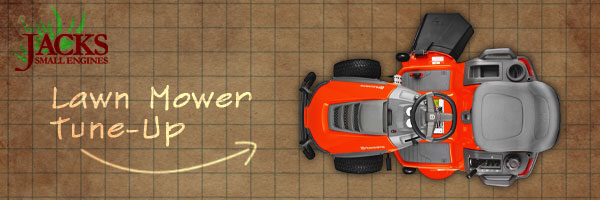How to Tune-Up Your Lawn Mower or Tractor
 Posted in Lawn Mowers and Small Engines
Posted in Lawn Mowers and Small EnginesConsult your owner's manual for specific guidelines and recommendations for your power equipment.
1) Lets Start with a Good Clean-Up
A little soap and water will make the job easier. If you have a pressure washer, feel free to use it. If you are using 1000+ PSI, be careful not to force dirt and water into the bearings, this may damage them. The high pressure spray will also wash away any lubricant that it hits.After a good cleaning, dry off your machine with a clean soft cloth.
2) Inspect the Deck, Belts, and Blades
If anything is broken or worn, replace it now. Check out our selection of lawn mower parts here at Jack's. Check your blades to see if they are loose or worn. Any movement more than 1/8" should be investigated. Make sure you replace any guides that you remove or are missing.If you have the deck off or tractor jacked up, remove the blades and have them sharpened. You can get the blades off by blocking the blade with a Blade Lock and unscrewing the blade bolt or nut. Wearing gloves is a good idea, especially when re-installing the sharpened or new blades.
Replace belts that have any signs of wear or are 4 seasons old. That way you are guaranteed to get through the next cutting season without any hassle having to replace more belts. Also check out our list of common causes of belt problems.
3) Lubricate and Check Air Pressure
Refer to your owner's manual to determine the right kind of lube that should be applied. Also, test the air in the tires for correct pressure. Low tire pressure can affect the quality of cut. Air pressure specs will be in the manual, too.4) Change the Oil
- Check the oil level. If it's ok, start the engine and allow it to warm up. This will make the oil easier to drain.
- Shut off the engine and drain the oil into a receptacle. For cleaner oil extraction, use an Oil Pump to remove the oil. Don't forget to replace the drain plug before refilling.
- If your engine is equipped with an oil filter, change it now. Fill the new oil filter with enough oil. This will prevent a dry engine start up. Then refill the engine with the proper engine oil.
5) Replace the Fuel Filter
Fuel filters are an essential part in keeping your small engine running efficiently. Begin changing the fuel filter by clamping off the fuel line between the tank and the fuel filter. Remove the filter by loosening the clamps, then pull it out of the hose. Be careful to catch any gasoline that may spill.Always replace the hose that is between the filter and the carburetor. Barbs on the fuel filter can tear the inside of the hose when it's removed. A piece of hose could enter the carb and cause serious problems.
6) Clean or Replace the Air Filter
Air filters ensure proper air flow to the carburetor. Clean or replace them as necessary. Be careful if you have an air compressor. Do not use high pressure that will create small holes in the filter.7) Inspect Engine Covers
Grass clippings and debris can gather on the cooling covers of your engine, also preventing proper air flow. You should clean clippings and debris off your machine after each use. If your mower has been in storage, check under the covers for signs of rodent nests (mice). They love making your equipment their winter home.8) Replace Spark Plugs
Replacing your spark plugs helps you get an easy start every time. If the plug is in a hard to reach area, use a piece of 1/4" fuel line to hold the plug. Then turn the hose to hand tighten the plug. Always thread the plug as far as it will go (or at least 2 full turns) by hand. Torque the spark plug to the manufacturers specifications.9) Check the Battery
The battery is often overlooked. It needs service, even if it started your unit right up. Just looking at the battery can save you from trouble later on.If the case looks bulged, replace the battery. Measure the voltage. If the voltage is below 9 volts, the battery probably will not last much longer. Inspect the terminals to make sure they are clean and tight. If not, fix them now or replace the bad battery parts. Fill the battery with water to the full mark and charge it with a battery charger.
10) Final Look-Over
While you are working around the mower, grab and shake things as you go. This is to help locate loose or missing parts. Rock the wheels to see if the bearings are loose or worn. Check the ball joints for signs of wear.Are all the deck hangers tight? Look for loose or missing bolts, clips or pins. Check the electrical wiring plugs too. It could save you a big repair bill later in the season.
You're done! After a tune-up, you'll be ready to tackle those lawn chores. Happy Mowing!
No comments:
Post a Comment